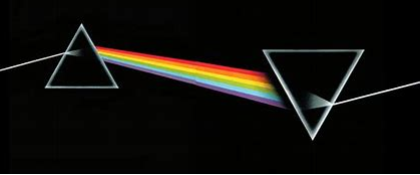Ed's
AV Handbook
Batting Practice for the AV Professional
and primer for the novice
Chapter 4 Page 2
Video Reproduction
Analog NTSC Color Television
This page outlines the expired technology that laid the framework for digital broadcast television -- analog NTSC color TV,
A NTSC color TV camera outputs five voltages: red, green, blue, horizontal sync, vertical sync*. But broadcast bandwidth could not handle all five voltages as is.NTSC color TV was also required to
maintain backward compatibility with legacy black and white
televisions. NTSC engineers ingenious solution reduced and
combined the five video voltages with a bit of algebraic magic,
a dash of modulating gymnastics, and a clever manipulation of
the human eye.
*
Horizontal and vertical sync are the start and finish points of
each video frame.

The following algebraic expression was their first step in a
recipe toward a workable broadcast signal.
Where
Y = Luminance,
R = Red
G = Green
B = Blue
Y = (0.3R + 0.59G + 0.11B)
The NTSC engineers had reduced the red, green, blue voltages and computed the black and white TV luminance voltage. But this first step was not enough to fit the video within broadcast bandwidth.
Squeezing RGB into A&C
The NTSC engineers next step squeezed the three abbreviated color voltages into only two color difference signals.
The Eye & TV Math
The NTSC solution began by combining an understanding of our sensitivity to light with a black and white luminance signal. Our sensitivity to light is not equal across the entire bandwidth of color. We are most sensitive to green light, less to red light, and least to blue. From the engineer's point of view, the green was most significant, red much less, blue least. Then, white light via a prism produces a rainbow of color, and the reverse recombines the rainbow as the original white light. Somewhat the same, NTSC engineers used this illuminating approach to create a black and white luminance signal. They produced a luminance signal with a mixture of reduced green voltage, less red, and even less blue.
Where
Y = Luminance,
R = Red
G = Green
B = Blue
Y = (0.3R + 0.59G + 0.11B)
The NTSC engineers had reduced the red, green, blue voltages and computed the black and white TV luminance voltage. But this first step was not enough to fit the video within broadcast bandwidth.
Squeezing RGB into A&C
The NTSC engineers next step squeezed the three abbreviated color voltages into only two color difference signals.
They converted 0.3R
0.59G 0.11B into:
A= (0.3R-Y)
and C = (0.11B-Y).
Component Video
To this point, NTSC engineers had produced a black and white luminance voltage 'Y' and reduced RGB color to A&C. The result of Y, A, & C was defined as component video.
Composite Video
The NTSC engineers still had a bandwidth issue.
Y, A, C bandwidth was still too large for broadcast.
The next step reduced A & C to I & Q.
I = 87.7% of A and Q = 49.3% of C
The NTSC engineers finally had a bandwidth solution via three manageable voltages: I, Q, & Y.
They defined I, Q, & Y as composite video.

The next NTSC step converted the three composite video voltages to radio-frequency (RF)
and encrypted the horizontal and vertical synchronizing signals.
The engineers assigned Y, I, & Q to two radio frequencies. Y was assigned an amplitude modulated frequency. I & Q, combined 90% out of phase, were assigned a phase modulated frequency. (similar to FM)
They hid the horizontal and vertical sync signals via a mathematical manipulation of the I & Q signals.
I will not include the calculation here. You can thank me later. A separate FM radio frequency carried the audio.
The NTSC signal was ready for broadcast.
A television station broadcast antenna initiated cycles of electromagnetic waves (continuous controlled sparks) that generated electromagnetic current in receiving TV antennas. The receiving television decoded the modulating RF signal as follows:
- Separate Y from I&Q
- Calculate the Horizontal & Vertical synchronizing voltages.
- Recover A&C from I&Q
If I = 87.7% of A
Component Video
To this point, NTSC engineers had produced a black and white luminance voltage 'Y' and reduced RGB color to A&C. The result of Y, A, & C was defined as component video.
Composite Video
The NTSC engineers still had a bandwidth issue.
Y, A, C bandwidth was still too large for broadcast.
The next step reduced A & C to I & Q.
I = 87.7% of A and Q = 49.3% of C
The NTSC engineers finally had a bandwidth solution via three manageable voltages: I, Q, & Y.
They defined I, Q, & Y as composite video.
Ready, Set, Broadcast

The next NTSC step converted the three composite video voltages to radio-frequency (RF)
and encrypted the horizontal and vertical synchronizing signals.
The engineers assigned Y, I, & Q to two radio frequencies. Y was assigned an amplitude modulated frequency. I & Q, combined 90% out of phase, were assigned a phase modulated frequency. (similar to FM)
They hid the horizontal and vertical sync signals via a mathematical manipulation of the I & Q signals.
I will not include the calculation here. You can thank me later. A separate FM radio frequency carried the audio.
The NTSC signal was ready for broadcast.
A television station broadcast antenna initiated cycles of electromagnetic waves (continuous controlled sparks) that generated electromagnetic current in receiving TV antennas. The receiving television decoded the modulating RF signal as follows:
- Separate Y from I&Q
- Calculate the Horizontal & Vertical synchronizing voltages.
- Recover A&C from I&Q
If I = 87.7% of A
and
Q = 49.3% of C
Then:
Then:
A = (I ÷ 87.7) x
(100)
C = (Q ÷ 49.3) x (100)
- Recover RGB from A&C
- Recover RGB from A&C
If A = (0.3R - Y) and C
= (0.11B-Y)
Then:
0.3R
= (0.3R - Y)
+ (Y)
0.11B = (0.11B-Y) + (Y)
0.59G
= (Y) - (0.3R +
0.11B)
Therefore:
Red = (0.3 Red ÷ 0.3) x (100)
Green = (0.59 Green ÷ 0.59) x (100)
Blue = (.011 Blue ÷ 0.11) x (100)
Red = (0.3 Red ÷ 0.3) x (100)
Green = (0.59 Green ÷ 0.59) x (100)
Blue = (.011 Blue ÷ 0.11) x (100)
The five video voltages, RGBHV,
were revived. The engineers could now recreate the
frames of lines and illuminated colored pixels captured by the
TV camera.
Ed's AV Handbook
Copyright 2007 Txu1-598-288 Revised 2024
Sponsored
By

Architectural Speaker Tuning System

Architectural Speaker Tuning System
for
in-wall/ceiling custom installed speakers.
Reclaim the performance you paid for.
Site Menu
Home
Table of
Contents
Handbook Chapters
1 AV
Terms
2 AV Physics
3 Sound Reproduction
4 Video Reproduction
5 The AV System Sequence
6 The Room, Speaker, & TV
7 Acoustical Strategy - Small Room
8 Home Theater by Design
9 AV Sales Training
10 AV Business & Marketing
Contact
About
